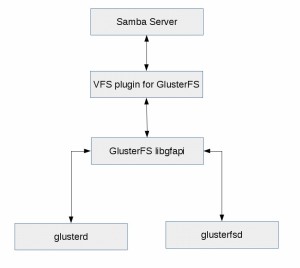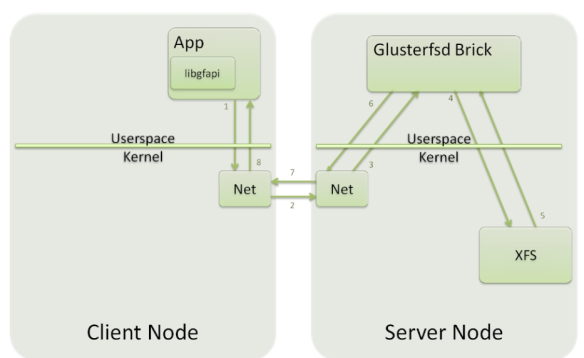This blog covers the steps and implementation details to use GlusterFS Samba VFS plugin.
Please refer below link, If you are looking for architectural information for GlusterFS Samba VFS plugin, difference between FUSE mount vs Samba VFS plugin
https://lalatendumohanty.wordpress.com/2014/04/20/glusterfs-vfs-plugin-for-samba/
I have setup two node GlusterFS cluster with Fedora 20 (minimal install) VMs. Each VM has 3 separate XFS partitions with each partitions 100GB each.
One of the Gluster node is used as a Samba server in this setup.
I had originally tested this with Fedora 20. But this example should work fine with latest Fedoras i.e. F21 and F22
GlusterFS Version: glusterfs-3.4.2-1.fc20.x86_64
Samba version: samba-4.1.3-2.fc20.x86_64
Post installation “df -h” command looked like below in the VMs
$df -h
Filesystem Size Used Avail Use% Mounted on
/dev/mapper/fedora_dhcp159–242-root 50G 2.2G 45G 5% /
devtmpfs 2.0G 0 2.0G 0% /dev
tmpfs 2.0G 0 2.0G 0% /dev/shm
tmpfs 2.0G 432K 2.0G 1% /run
tmpfs 2.0G 0 2.0G 0% /sys/fs/cgroup
tmpfs 2.0G 0 2.0G 0% /tmp
/dev/vda1 477M 103M 345M 23% /boot
/dev/mapper/fedora_dhcp159–242-home 45G 52M 43G 1% /home
/dev/mapper/gluster_vg1-gluster_lv1 100G 539M 100G 1% /gluster/brick1
/dev/mapper/gluster_vg2-gluster_lv2 100G 406M 100G 1% /gluster/brick2
/dev/mapper/gluster_vg3-gluster_lv3 100G 33M 100G 1% /gluster/brick3
You can use following commands to create xfs partitions
1. pvcreate /dev/vdb
2. vgcreate VG_NAME /dev/vdb
3. lvcreate -n LV_NAME -l 100%PVS VG_NAME /dev/vdb
4. mkfs.xfs -i size=512 LV_PATH
Following are the steps and packages need to be performed/installed on each node (which is Fedora 20 for mine)
#Change SELinux to either “permissive” or “disabled” mode
# To put SELinux in permissive mode
$setenforce 0
#To see the current mode of SELinux
$getenforce
SELinux policy rules for Gluster is present in recent Fedora releases e.g. F21, F22 or later. So SELinux should work fine with Gluster.
#Remove all iptable rules, so that it does not interfare with Gluster
$iptables -F
yum install glusterfs-server
yum install samba-vfs-glusterfs
yum install samba-client
#samba-vfs-glusterfs RPMs for CentOS, RHEL, Fedora19/18 are avialable at http://download.gluster.org/pub/gluster/glusterfs/samba/
#To start glusterd and auto start it after boot
$systemctl start glusterd
$systemctl enable glusterd
$systemctl status glusterd
#To start smb and auto start it after boot
$systemctl start smb
$systemctl enable smb
$systemctl status smb
#Create gluster volume and start it. (Running below commands from Server1_IP)
$gluster peer probe Server2_IP
$gluster peer status
Number of Peers: 1
Hostname: Server2_IP
Port: 24007
Uuid: aa6f71d9-0dfe-4261-a2cd-5f281632aaeb
State: Peer in Cluster (Connected)
$gluster v create testvol Server2_IP:/gluster/brick1/testvol-b1 Server1_IP:/gluster/brick1/testvol-b2
$gluster v start testvol
#Modify smb.conf for Samba share
$vi /etc/samba/smb.conf
#
[testvol]
comment = For samba share of volume testvol
path = /
read only = No
guest ok = Yes
kernel share modes = No
vfs objects = glusterfs
glusterfs:loglevel = 7
glusterfs:logfile = /var/log/samba/glusterfs-testvol.log
glusterfs:volume = testvol
#For debug logs you can change the log levels to 10 e.g: “glusterfs:loglevel = 10”
# Do not miss “kernel share modes = No” else you won’t be able to write anything in to the share
#verify that your changes are correctly understood by Samba
$testparm -s
Load smb config files from /etc/samba/smb.conf
rlimit_max: increasing rlimit_max (1024) to minimum Windows limit (16384)
Processing section “[homes]”
Processing section “[printers]”
Processing section “[testvol]”
Loaded services file OK.
Server role: ROLE_STANDALONE
[global]
workgroup = MYGROUP
server string = Samba Server Version %v
log file = /var/log/samba/log.%m
max log size = 50
idmap config * : backend = tdb
cups options = raw
[homes]
comment = Home Directories
read only = No
browseable = No
[printers]
comment = All Printers
path = /var/spool/samba
printable = Yes
print ok = Yes
browseable = No
[testvol]
comment = For samba share of volume testvol
path = /
read only = No
guest ok = Yes
kernel share modes = No
vfs objects = glusterfs
glusterfs:loglevel = 10
glusterfs:logfile = /var/log/samba/glusterfs-testvol.log
glusterfs:volume = testvol
#Restart the Samba service. This not a compulsory step as Samba takes latest smb.conf for new connections. But to make sure it uses the latest smb.conf, restart the service.
$systemctl restart smb
#Set smbpasswd for root. This will be used for mounting the volume/Samba share on the client
$smbpasswd -a root
#Mount the cifs share using following command and it is ready for use 🙂
mount -t cifs -o username=root,password=<smbpassword> //Server1_IP/testvol /mnt/cifs
GlusterFS volume tuning for volume shared through Samba:
- Gluster volume needs to have: “gluster volume set volname server.allow-insecure on”
- /etc/glusterfs/glusterd.vol of each of gluster node
add “option rpc-auth-allow-insecure on”
- Restart glusterd of each node.
For setups where Samba server and Gluster nodes need to be on different machines:
# put “glusterfs:volfile_server = <server name/ip>” in the smb.conf settings for the specific volume
e.g:
[testvol]
comment = For samba share of volume testvol
path = /
read only = No
guest ok = Yes
kernel share modes = No
vfs objects = glusterfs
glusterfs:loglevel = 7
glusterfs:logfile = /var/log/samba/glusterfs-testvol.log
glusterfs:volfile_server = <server name/ip>
glusterfs:volume = testvol
#Here are the packages that were installed on the nodes
rpm -qa | grep gluster
glusterfs-libs-3.4.2-1.fc20.x86_64
glusterfs-api-3.4.2-1.fc20.x86_64
glusterfs-3.4.2-1.fc20.x86_64
glusterfs-cli-3.4.2-1.fc20.x86_64
glusterfs-server-3.4.2-1.fc20.x86_64
samba-vfs-glusterfs-4.1.3-2.fc20.x86_64
glusterfs-devel-3.4.2-1.fc20.x86_64
glusterfs-fuse-3.4.2-1.fc20.x86_64
glusterfs-api-devel-3.4.2-1.fc20.x86_64
[root@dhcp159-242 ~]# rpm -qa | grep samba
samba-client-4.1.3-2.fc20.x86_64
samba-4.1.3-2.fc20.x86_64
samba-vfs-glusterfs-4.1.3-2.fc20.x86_64
samba-libs-4.1.3-2.fc20.x86_64
samba-common-4.1.3-2.fc20.x86_64
Note: The same smb.conf entries should work with CentOS6 too.
16.231569
74.531250



